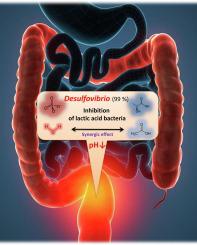Journal of Advanced Research ( IF 10.7 ) Pub Date : 2020-03-24 , DOI: 10.1016/j.jare.2020.03.007 Ivan Kushkevych 1, 2 , Dani Dordević 3 , Monika Vítězová 1

|
Introduction
Increased numbers of sulfate-reducing bacteria (SRB) are often found in the feces of people and animals with inflammatory bowel disease. The final products of their metabolism are hydrogen sulfide and acetate, which are produced during dissimilatory sulfate reduction process.
Objectives
The aim of the study was to monitor processes concerning sulfate reduction microbial metabolisms, including: the main microbial genera monitoring and their hydrogen sulfide production in the intestines of healthy and not healthy individuals, phylogenetic analysis of SRB isolates, cluster analysis of SRB physiological and biochemical parameters, SRB growth kinetic parameters calculation, same as the application of the two-factor dispersion analysis for finding relationship between SRB biomass accumulation, temperature and pH. Feces samples from healthy people and patients with colitis were used for isolation of sulfate-reducing microbial communities.
Methods
Microbiological, biochemical, biophysical, molecular biology methods, and statistical processing of the results have been used for making an evaluation of gained results.
Results
Two dominant SRB morphotypes differed in colony size and quantitative ratio in the feces of healthy and colitis patients were observed and identified. In the feces of healthy people, 93% of SRB of morphotype I prevailed (Desulfovibrio) while morphotype II made only 7% (Desulfomicrobium); in the feces of patients with colitis, the ratio of these morphotypes was 99:1, respectively. Hydrogen sulfide concentrations are also higher in the feces of people with colitis and certain synergy effects exist among acetate produced by SRB.
Conclusions
The study results brought important findings concerning colony environments with developed colitis and these findings can lead to the development of possible risk indicators of ulcerative colitis prevalence.
中文翻译:

硫酸盐还原菌产生的硫化氢和醋酸盐对炎症性肠病发展的可能协同作用
介绍
经常在患有炎症性肠病的人和动物的粪便中发现数量增加的硫酸盐还原菌 (SRB)。它们代谢的最终产物是硫化氢和乙酸盐,它们是在异化硫酸盐还原过程中产生的。
目标
该研究的目的是监测硫酸盐还原微生物代谢过程,包括:主要微生物属监测及其在健康和非健康个体肠道中的硫化氢产生、SRB分离株的系统发育分析、SRB生理生化聚类分析参数,SRB生长动力学参数计算,与应用二因素离散分析寻找SRB生物量积累、温度和pH之间的关系相同。来自健康人和结肠炎患者的粪便样本用于分离硫酸盐还原微生物群落。
方法
微生物学、生物化学、生物物理学、分子生物学方法和结果的统计处理已用于对获得的结果进行评估。
结果
观察和鉴定了健康和结肠炎患者粪便中两种主要的 SRB 形态型,其菌落大小和数量比不同。在健康人的粪便中,93% 的 SRB 形态 I 型(Desulfovibrio)占优势,而形态 II 型仅占 7% (Desulfomicrobium);在结肠炎患者的粪便中,这些形态类型的比例分别为 99:1。结肠炎患者粪便中的硫化氢浓度也较高,SRB 产生的醋酸盐之间存在一定的协同作用。
结论
研究结果带来了有关患有结肠炎的菌落环境的重要发现,这些发现可能导致溃疡性结肠炎患病率的可能风险指标的发展。



























 京公网安备 11010802027423号
京公网安备 11010802027423号